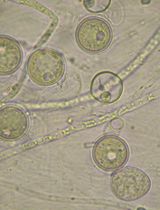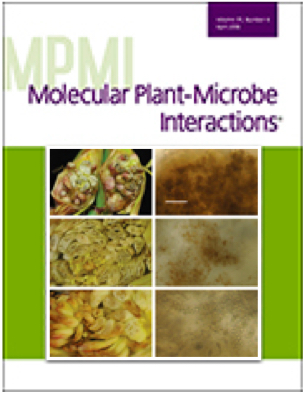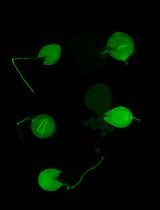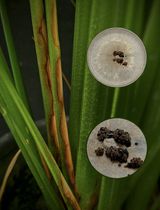- EN - English
- CN - 中文
Mating and Progeny Isolation in the Corn Smut Fungus Ustilago maydis
玉蜀黎黑粉菌的融合和后代分离
发布: 2016年04月20日第6卷第8期 DOI: 10.21769/BioProtoc.1793 浏览次数: 11984
评审: Zhaohui LiuChijioke JoshuaAnonymous reviewer(s)

相关实验方案

微生物提取物对卵菌辣椒疫霉菌和猝倒病疫霉的体外筛选
Mónica Trigal Martínez [...] María Ángeles Vinuesa Navarro
2025年09月20日 1195 阅读
Abstract
The corn smut pathogen, Ustilago maydis (U. maydis) (DC.) Corda, is a semi-obligate plant pathogenic fungus in the phylum Basidiomycota (Alexopoulos et al., 1996). The fungus can be easily cultured in its haploid yeast phase on common laboratory media. However, to complete its sexual cycle U. maydis strictly requires its specific plant host, maize (Zea mays). The fungus is an interesting and important model organism for the study of the interactions of fungal biotrophic pathogens with plants. In this protocol, we describe the process of plant inoculation, teliospore recovery, germination, progeny isolation and initial mating type analysis. The primary purpose of this protocol is to identify individual progeny strains of U. maydis that can be used for downstream genetic analyses. Generation of targeted mutants to study various processes is a common approach with this and many plant pathogenic fungi. The ability to generate combinations of mutations is facilitated by sexual crossing without the need for additional selectable markers.
Materials and Reagents
- Plastic sterile syringes: 3 ml (BD, catalog number: 309657 ) and 10 ml (BD, catalog number: 309604 )
- Needles: 22 gauge (BD, EclipseTM, catalog number: 305768 ) and 27 gauge (BD, EclipseTM, catalog number: 305758 )
- Conical tubes: Falcon® 50 ml (Corning, catalog number: 352070 )
- Test tubes
- 1.5 ml Microfuge tubes (Thermo Fisher Scientific, catalog number: 05-408-130 )
- Haploid Ustilago maydis tester strains of known mating type
- Seeds for maize seedling assay: Variety Golden Bantam (Rich Farm Garden Supply)
- Seeds for maize ear inoculation: Variety Tom Thumb (Seed Savers Exchange)
- Sterile distilled water (sdH2O)
- CuSO4 solution (1%) (Sigma-Aldrich, catalog number: 451657 )
- Casamino acids (Becton, Dickinson and Company, catalog number: 223050 )
- Ammonium nitrate (Sigma-Aldrich, catalog number: A9642 )
- Yeast extract (Sigma-Aldrich, catalog number: Y1625 )
- Activated charcoal (Sigma-Aldrich, catalog number: C9157 )
- Potassium phosphate monobasic (KH2PO4) (Sigma-Aldrich, catalog number: P5655 )
- Sodium sulfate (Na2SO4) (Sigma-Aldrich, catalog number: 239313 )
- Calcium chloride dihydrate (CaCl2·2H2O) (Sigma-Aldrich, catalog number: 223506 )
- Boric acid (H3BO3 ) (Sigma-Aldrich, catalog number: B6768 )
- Manganese(II) chloride (MnCl2) (Sigma-Aldrich, catalog number: 244589 )
- Zinc chloride (ZnCl2 ) (Sigma-Aldrich, catalog number: 746355 )
- Sodium molybdate dehydrate (Na2MoO4·2H2O) (Sigma-Aldrich, catalog number: 331058 )
- Iron(III) chloride (FeCl3) (Sigma-Aldrich, catalog number: 157740 )
- Potato dextrose agar (PDA) 2% agar (Sigma-Aldrich) (see Recipes)
- Potato dextrose broth (PDB) (Sigma-Aldrich) (see Recipes)
- Charcoal mating plate medium (see Recipes)
- U. maydis salt solution (Sigma-Aldrich) (see Recipes)
- Trace element solution (Sigma-Aldrich) (see Recipes)
Equipment
- Glass stirring rods
- Pipettes
- Ceramic mortars and pestles
- Sterile cheesecloth
- Hemocytometer or automated cell counter
- Light microscope
- Centrifuge holding 50 ml conical tubes (Beckman Coulter, model: J25I ) with a JS7.5 rotor (Beckman Coulter)
- Growth chamber (Conviron, model: E15 )
- Laminar flow hood
- Rotational Incubator (VWR International, New Brunswick model: 12500KC )
- Stationary incubator (PrecisionTM, model: 815 )
Procedure
文章信息
版权信息
© 2016 The Authors; exclusive licensee Bio-protocol LLC.
如何引用
Nadal, M., Takach, J. E., Andrews, D. L. and Gold, S. E. (2016). Mating and Progeny Isolation in the Corn Smut Fungus Ustilago maydis. Bio-protocol 6(8): e1793. DOI: 10.21769/BioProtoc.1793.
分类
植物科学 > 植物免疫 > 宿主-细菌相互作用
微生物学 > 微生物遗传学 > 基因图谱和克隆
分子生物学 > DNA > DNA 克隆
您对这篇实验方法有问题吗?
在此处发布您的问题,我们将邀请本文作者来回答。同时,我们会将您的问题发布到Bio-protocol Exchange,以便寻求社区成员的帮助。
Share
Bluesky
X
Copy link










